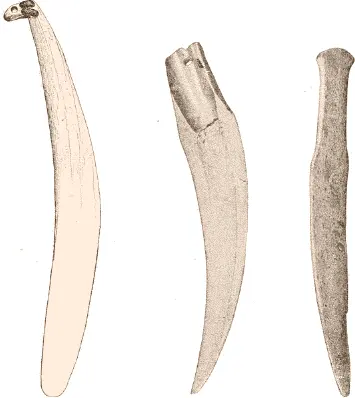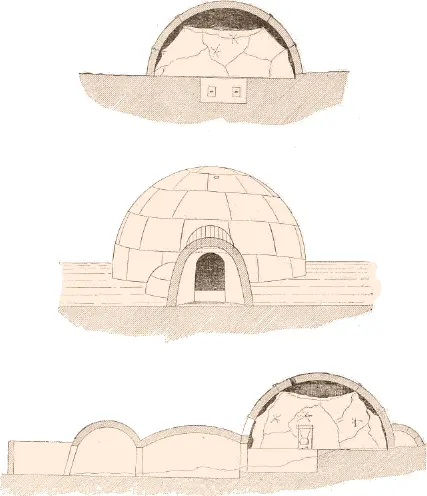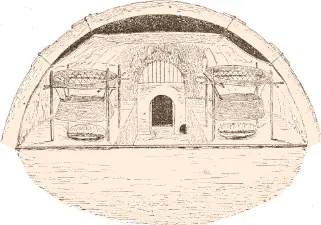
Fig. 490. Various styles of snow knife. (National Museum, Washington. a , 10386; b , 10385.)
Two men unite in building a house, the one cutting the blocks, the other building. At first a row of blocks is put up in a circle, the single pieces being slanted so as to fit closely together. Then the first block is cut down to the ground and the top of the row is slanted so as to form one thread of a spiral line. The builder places the first block of the second row with its narrow side upon the first block and pushes it with his left hand to the right so that it touches the last block of the first row. Thus the snow block, which is inclined a little inward, has a support on two sides. The vertical joint is slanted with the snow knife and tightly pressed together, the new block resting on the oblique side of the former. In building on in this way the blocks receive the shape of almost regular trapezoids. Every block is inclined a little more inward than the previous one, and as the angle to the vertical becomes greater the blocks are only kept in their places by the neighboring ones. In order to give them a good support the edges are the more slanted as their angle is greater.
This method of building is very ingenious, as it affords the possibility of building a vault without a scaffold. If the blocks were placed in parallel rows, the first block of a new row would have no support, while by this method each reclines on the previous one. When the house has reached a considerable height the man who cuts the blocks outside must place them upon the last row. The builder supports them with his head and pushes them to their proper places. The key block and those which are next to it are either cut inside or pushed into the house through a small door cut for the purpose. The key block is generally shaped irregularly, as it is fitted into the hole which remains; usually the last two blocks are triangular. When the vault is finished the joints between the blocks are closed up by cutting down the edges and pressing the scraps into the joints. Larger openings are closed with snow blocks and filled up with loose snow pressed into the fissures. Thus the whole building becomes a tight vault, without any holes through which the warm air inside may escape. Such a snow house, about five feet high and seven feet in diameter, is used as a camp in winter journeys. It takes about two hours for two skilled men to build and finish it. For winter quarters the vaults are built from ten to twelve feet high and twelve to fifteen feet in diameter. In order to reach this height the builder makes a bench on which he steps while finishing the upper part of the building.
The plan of a snow house of the Davis Strait tribes is a little different from that of the Hudson Bay and the Iglulik tribes.
I shall first describe the former according to my own observations (Figs. 491 and 492).

Fig. 491. Ground plan of snow house of Davis Strait tribes.
The entrance to the main building is formed by two, or less frequently by three, small vaults. The first one (uadling) is a small dome about six feet in height, with a door two and a half feet in height; the second one is a long passage of equal height formed by an elliptical vault (igdluling). Its roof is generally arched, but sometimes the top is cut off evenly and covered with slabs of snow. Both vaults together form the entrance and are called toqsung. A door about three feet high leads into the main room, the floor of which is about nine inches above that of the former. Two very small vaults are always attached to the whole building (Fig. 491). One is situated alongside of the uadling and the igdluling, and serves as a storeroom for clothing and harness (sirdloang). It is not connected with the interior of the hut, but one of the blocks of the vault can be taken out and is made to serve as a lid. On the left side of the entrance of the main building is another small vault (igdluarn), which is accessible from the main building. It serves for keeping spare meat and blubber. Frequently there is a second igdluarn on the opposite side, and sometimes even a third one in the igdluling. Another appendix of the main building is frequently used, the audlitiving (Fig. 491 and Fig. 492 c ). It is a vault similar to the sirdloang and is attached to the back of the main room. It serves for storing up meat for future use.
Directly over the entrance a window is cut through the wall, either square or more frequently forming an arch, which is generally covered with the intestines of ground seals, neatly sewed together, the seams standing vertically (Fig. 493). In the center there is a hole (qingang) through which one can look out. In some instances a piece of fresh water ice is inserted in the hole. According to Ross it is always used by the Netchillirmiut (II, p. 250), who make the slab by letting water freeze in a sealskin.

Fig. 492. Snow house of Davis Strait, sections.
In the rear half and on both sides of the door a bank of snow two and a half feet high is raised and cut off straight, a passage trench five feet wide and six feet long remaining. The rear half forms the bed, the adjoining parts of the side benches are the place for the lamps, while on both sides of the entrance meat and refuse are heaped up. Frequently the snowbank on which the hut is built is deep enough so that the bed needs very little raising, and the passage is cut into the bank. As this is much more convenient in building, the huts are generally erected on a sloping face, the entrance lying on the lower part, which faces the beach.

Fig. 493. Section and interior of snow house.
Before the bed is arranged and the hut furnished the vault is lined with skins, frequently with the cover of the summer hut. The lining (ilupiqang) is fastened to the roof by small ropes (nirtsun), which are fastened by a toggle on the outside of the wall (Fig. 493). In the lower part of the building the lining lies close to the wall; in the upper part it forms a flat roof about two or three feet below the top of the vault. The effect of this arrangement is to prevent the warm air inside from melting the snow roof, as above the skins there is always a layer of colder air. Close to the top of the building a small hole (qangirn) is cut through the wall for ventilation. The lamps require a good draught, which is secured by this hole. The cold air enters through the door, slowly filling the passage, and after being warmed rises to the lamps and escapes through the skin cover and the hole. The moisture of the air forms long ice needles on the inside of the roof. Sometimes they fall down upon the skins, and must be immediately removed by shaking it until they glide down at the sides, else they melt and wet the room thoroughly. Frequently a high ice funnel forms around the hole from the freezing moisture of the escaping air.
The southern and western tribes rarely line the snow house. The continuous dropping from the roof, however, causes great inconvenience, and, besides, the temperature cannot be raised higher than two or three degrees centigrade above the freezing point, while in the lined houses it is frequently from ten to twenty degrees centigrade, so that the latter are much more comfortable. To avoid the dropping the natives apply a cold piece of snow to the roof before the drop falls down, which at once freezes to it, the roof acquiring by this repeated process a stalactitic appearance. The eastern tribes use the lining in their permanent houses without any exception. The western and southern tribes, who leave the walls bare, heap a thick layer of loose snow over the whole building, almost covering it up, the window and the ventilating hole alone excepted. For this purpose snow shovels are used.
Читать дальше
















